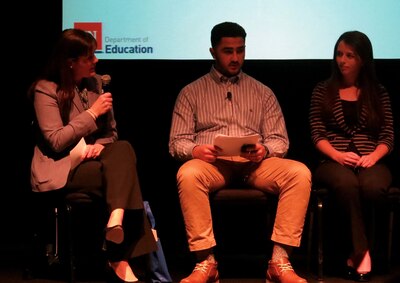For Tennessee’s recent graduates, a high school diploma will only fetch an average annual salary of about $11,000.
And yet, too few high school graduates are furthering their education to prepare for jobs that can earn them $800,000 more over a lifetime than those with just a high school diploma.
Bridging that gap is the challenge that brought together Gov. Bill Haslam, Education Commissioner Candice McQueen, business leaders and educators on Thursday at Nashville’s Cane Ridge High School.
Nearly 90 percent of Tennessee ninth-graders are graduating from high school in four years, but only about 35 percent of those students go on to a postsecondary program of study.
Haslam says the state has to do more to support high school educators in helping students identify pathways to take them from high school to college and career.
“We don’t want Tennessee students to find themselves in a dead end after high school,” he said. “We must pursue and promote real choices in course offerings for our students.”
The event highlighted the state’s efforts to offer supports that equip students for life after high school. It coincided with the release of a report from the State Department of Education built on months of conversations with high school students who said they aren’t receiving adequate resources or guidance to set them on a pathway toward college or career. Many students shared frustration about too few guidance counselors, as well as a lack of course options and exposure to opportunities outside of school.
The report’s recommendations include more support for school counselors, as well as ensuring that more schools have college credit-bearing courses like dual enrollment or advanced placement classes, or have vocational programs that fit with industry needs.

“Now that I’m in college, I realize those dual-enrollment courses would have prepared me for the heavy load,” said Shaquille Phipps, a Tennessee State University student and recent graduate of Oakhaven High School in Memphis. “(College) is like running a marathon. (Students who earned credit in high school) are jogging along pretty nicely. I’m sweating, about to pass out.”
McQueen said the state must undertake concrete actions to address underlying inequities keeping Tennessee students from success.
“We have an opportunity to not only lead but serve all students, and remove barriers and go deeper into this work,” she said. “We have seen and heard that there are still systemic barriers for our high school students to actually reach success.”
The responsibilities for offering college and career guidance to students typically falls on the shoulders of high school counselors. But in Tennessee in 2015, the student-to-school counselor ratio was 439:1, compared with the national recommended ratio of 250:1. School counselors also are often tasked with non-counseling duties such as coordinating testing.
The report recommends that the responsibility for after-graduation preparedness be shared among middle and high school faculty and staff, and that the state should work to support those school and district efforts.
Educators should also communicate with students about post-high school education and career options early and often, the report says. The junior and senior years of high school are too late.
The event built on the state’s Drive to 55 initiative, launched in 2014 with the goal of getting 55 percent of Tennesseans equipped with a college degree or certificate by the year 2025.
Cane Ridge High School was chosen as the backdrop for the discussions after increasing postsecondary enrollment among graduates from 55 percent in 2013 to 62 percent in 2015, one of the largest increases by a large urban high school in the state. The increase is especially meaningful because more than 75 percent of the school’s 1,700 racially diverse students are economically disadvantaged, and most will be the first in their families to go to college.

